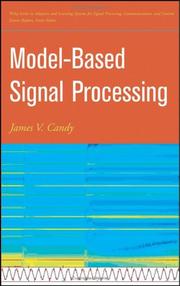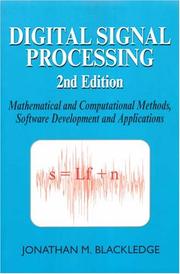| Listing 1 - 10 of 156 | << page >> |
Sort by
|
Book
ISBN: 078039710X 0780397118 1509095217 9781509095216 9780780397118 Year: 2006 Publisher: [Place of publication not identified] I E E E
Abstract | Keywords | Export | Availability | Bookmark
 Loading...
Loading...Choose an application
- Reference Manager
- EndNote
- RefWorks (Direct export to RefWorks)
Periodical
Abstract | Keywords | Export | Availability | Bookmark
 Loading...
Loading...Choose an application
- Reference Manager
- EndNote
- RefWorks (Direct export to RefWorks)

ISBN: 128023556X 9786610235568 0470306637 0471732672 0471732664 9780471732679 9780471236320 0471236322 9780471732662 Year: 2006 Publisher: Hoboken, N.J. : IEEE Press : Wiley-Interscience,
Abstract | Keywords | Export | Availability | Bookmark
 Loading...
Loading...Choose an application
- Reference Manager
- EndNote
- RefWorks (Direct export to RefWorks)
A unique treatment of signal processing using a model-based perspective Signal processing is primarily aimed at extracting useful information, while rejecting the extraneous from noisy data. If signal levels are high, then basic techniques can be applied. However, low signal levels require using the underlying physics to correct the problem causing these low levels and extracting the desired information. Model-based signal processing incorporates the physical phenomena, measurements, and noise in the form of mathematical models to solve this problem. Not only does the approach enable signal processors to work directly in terms of the problem's physics, instrumentation, and uncertainties, but it provides far superior performance over the standard techniques. Model-based signal processing is both a modeler's as well as a signal processor's tool. Model-Based Signal Processing develops the model-based approach in a unified manner and follows it through the text in the algorithms, examples, applications, and case studies. The approach, coupled with the hierarchy of physics-based models that the author develops, including linear as well as nonlinear representations, makes it a unique contribution to the field of signal processing. The text includes parametric (e.g., autoregressive or all-pole), sinusoidal, wave-based, and state-space models as some of the model sets with its focus on how they may be used to solve signal processing problems. Special features are provided that assist readers in understanding the material and learning how to apply their new knowledge to solving real-life problems. * Unified treatment of well-known signal processing models including physics-based model sets * Simple applications demonstrate how the model-based approach works, while detailed case studies demonstrate problem solutions in their entirety from concept to model development, through simulation, application to real data, and detailed performance analysis * Summaries provided with each chapter ensure that readers understand the key points needed to move forward in the text as well as MATLAB(r) Notes that describe the key commands and toolboxes readily available to perform the algorithms discussed * References lead to more in-depth coverage of specialized topics * Problem sets test readers' knowledge and help them put their new skills into practice The author demonstrates how the basic idea of model-based signal processing is a highly effective and natural way to solve both basic as well as complex processing problems. Designed as a graduate-level text, this book is also essential reading for practicing signal-processing professionals and scientists, who will find the variety of case studies to be invaluable. An Instructor's Manual presenting detailed solutions to all the problems in the book is available from the Wiley editorial department.
Book
Year: 2006 Publisher: Karlsruhe : KIT Scientific Publishing,
Abstract | Keywords | Export | Availability | Bookmark
 Loading...
Loading...Choose an application
- Reference Manager
- EndNote
- RefWorks (Direct export to RefWorks)
In dieser Arbeit werden adaptive Methoden zur Analyse von Anthropomatikdaten entwickelt. Zielsetzung ist die automatische Erkennung von Systemzuständen mit Hidden-Markov-Modellen. Anwendungsbeispiele sind Bohrgeräusche aus der Wirbelsäulenchirurgie, medizinische Ultraschallbilder und menschliche Bewegungsdaten. Neben dem Vergleich mit anderen Klassifikationsverfahren werden Merkmalsgenerierung, geeignete Modellstrukturen, Optimierung der Zustände und Aspekte der Implementierung besprochen.
Book
Year: 2006 Publisher: Karlsruhe : KIT Scientific Publishing,
Abstract | Keywords | Export | Availability | Bookmark
 Loading...
Loading...Choose an application
- Reference Manager
- EndNote
- RefWorks (Direct export to RefWorks)
In dieser Arbeit werden adaptive Methoden zur Analyse von Anthropomatikdaten entwickelt. Zielsetzung ist die automatische Erkennung von Systemzuständen mit Hidden-Markov-Modellen. Anwendungsbeispiele sind Bohrgeräusche aus der Wirbelsäulenchirurgie, medizinische Ultraschallbilder und menschliche Bewegungsdaten. Neben dem Vergleich mit anderen Klassifikationsverfahren werden Merkmalsgenerierung, geeignete Modellstrukturen, Optimierung der Zustände und Aspekte der Implementierung besprochen.
Book
Year: 2006 Publisher: Karlsruhe : KIT Scientific Publishing,
Abstract | Keywords | Export | Availability | Bookmark
 Loading...
Loading...Choose an application
- Reference Manager
- EndNote
- RefWorks (Direct export to RefWorks)
In dieser Arbeit werden adaptive Methoden zur Analyse von Anthropomatikdaten entwickelt. Zielsetzung ist die automatische Erkennung von Systemzuständen mit Hidden-Markov-Modellen. Anwendungsbeispiele sind Bohrgeräusche aus der Wirbelsäulenchirurgie, medizinische Ultraschallbilder und menschliche Bewegungsdaten. Neben dem Vergleich mit anderen Klassifikationsverfahren werden Merkmalsgenerierung, geeignete Modellstrukturen, Optimierung der Zustände und Aspekte der Implementierung besprochen.
Book
ISBN: 1107169682 1280709839 9786610709830 0511257090 0511257570 0511256027 0511319754 0511607466 1601197284 0511256590 Year: 2006 Publisher: Cambridge : Cambridge University Press,
Abstract | Keywords | Export | Availability | Bookmark
 Loading...
Loading...Choose an application
- Reference Manager
- EndNote
- RefWorks (Direct export to RefWorks)
Adaptive signal processing (ASP) and iterative signal processing (ISP) are important techniques in improving receiver performance in communication systems. Using examples from practical transceiver designs, this 2006 book describes the fundamental theory and practical aspects of both methods, providing a link between the two where possible. The first two parts of the book deal with ASP and ISP respectively, each in the context of receiver design over intersymbol interference (ISI) channels. In the third part, the applications of ASP and ISP to receiver design in other interference-limited channels, including CDMA and MIMO, are considered; the author attempts to illustrate how the two techniques can be used to solve problems in channels that have inherent uncertainty. Containing illustrations and worked examples, this book is suitable for graduate students and researchers in electrical engineering, as well as practitioners in the telecommunications industry.
Periodical
ISSN: 2150301X Year: 2006 Publisher: [Piscataway, NJ] : Institute of Electrical and Electronics Engineers,
Abstract | Keywords | Export | Availability | Bookmark
 Loading...
Loading...Choose an application
- Reference Manager
- EndNote
- RefWorks (Direct export to RefWorks)
Genomics --- Signal processing --- Genomics. --- Signal processing. --- Signal Transduction

ISBN: 0857099450 1904275265 9780857099457 9781904275268 Year: 2006 Publisher: Chichester
Abstract | Keywords | Export | Availability | Bookmark
 Loading...
Loading...Choose an application
- Reference Manager
- EndNote
- RefWorks (Direct export to RefWorks)
This book forms the first part of a complete MSc course in an area that is fundamental to the continuing revolution in information technology and communication systems. Massively exhaustive, authoritative, comprehensive and reinforced with software, this is an introduction to modern methods in the developing field of Digital Signal Processing (DSP). The focus is on the design of algorithms and the processing of digital signals in areas of communications and control, providing the reader with a comprehensive introduction to the underlying principles and mathematical models.Provi
Book
ISBN: 1424401666 1509095365 9781509095360 Year: 2006 Publisher: [Place of publication not identified] IEEE
Abstract | Keywords | Export | Availability | Bookmark
 Loading...
Loading...Choose an application
- Reference Manager
- EndNote
- RefWorks (Direct export to RefWorks)
| Listing 1 - 10 of 156 | << page >> |
Sort by
|

 Search
Search Feedback
Feedback About UniCat
About UniCat  Help
Help News
News